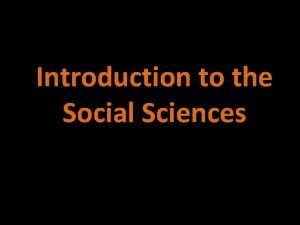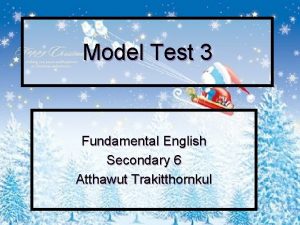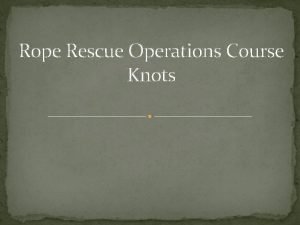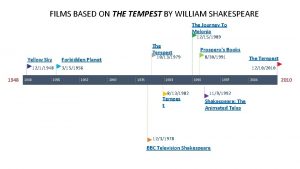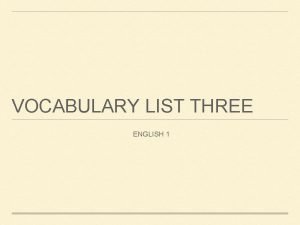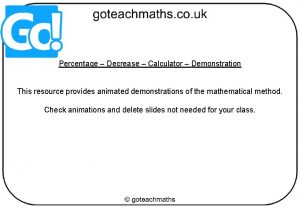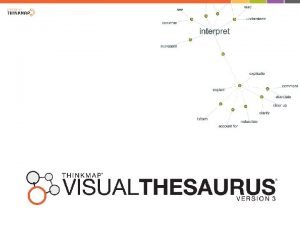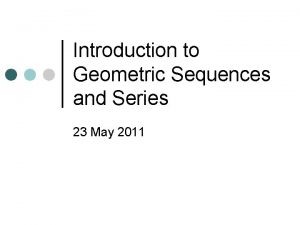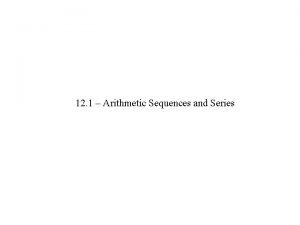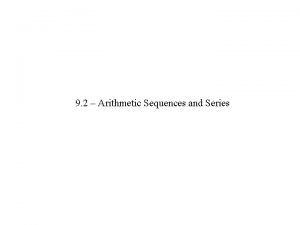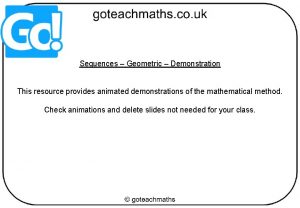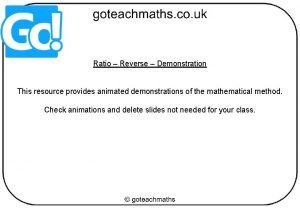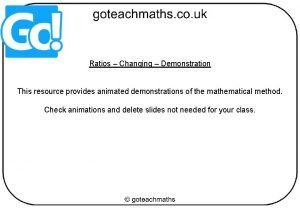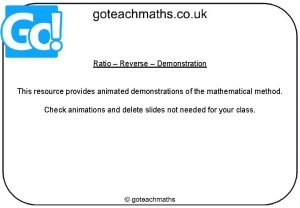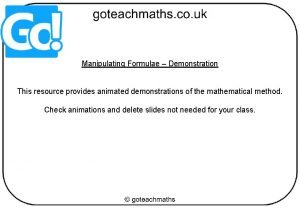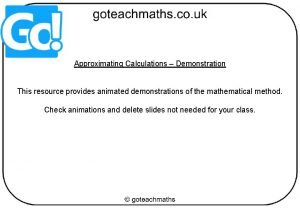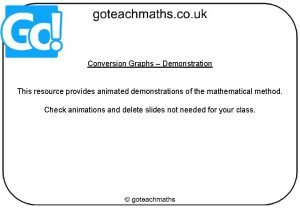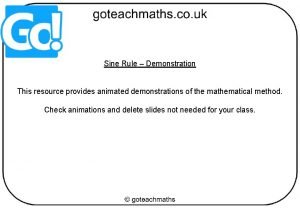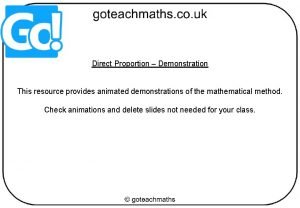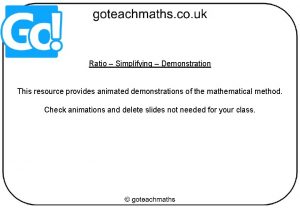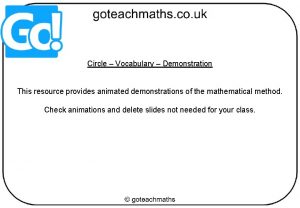Sequences Introduction Demonstration This resource provides animated demonstrations





















- Slides: 21

Sequences – Introduction – Demonstration This resource provides animated demonstrations of the mathematical method. Check animations and delete slides not needed for your class.

Patterns Which of these have a pattern? What is a pattern? 3, 6, 9, 12, 15 Ant Bat Cat Dog Elephant 5, 7, 9, 11, 13, 15 5, 10, 20, 40, 80

Patterns are objects in an order. Patterns follow rules, so we know what will happen next. Describe the rule for this pattern. What are the next objects in the pattern?

Patterns are objects in an order. Patterns follow rules, so we know what will happen next. Describe the rule for this pattern. What are the next objects in the pattern?

Patterns are objects in an order. Patterns follow rules, so we know what will happen next. Describe the rule for this pattern. What are the next objects in the pattern?

Patterns are objects in an order. Patterns follow rules, so we know what will happen next. Describe the rule for this pattern. What are the next objects in the pattern?

Patterns are objects in an order. Patterns follow rules, so we know what will happen next. Describe the rule for this pattern. What are the next objects in the pattern?

Patterns are objects in an order. Patterns follow rules, so we know what will happen next. Describe the rule for this pattern. What are the next objects in the pattern?

Shape patterns often grow. What is the rule for this pattern? How many yellow & how many blue squares do we expect in the next shape?

Shape patterns often grow. What is the rule for this pattern? How many yellow & how many red squares do we expect in the next shape?

We can record a pattern to help us find the rule. What can we predict for shape 5? Shape Number Red squares Yellow squares 1 1 1 2 2 3 3 3 5 4 4 7 5 5 9

We can record a pattern to help us find the rule. What can we predict for shape 5? Shape Number White squares Blue squares 1 1 2 2 2 4 3 3 6 4 4 8 5 5 10 What is the connection between the shape number & the number of white & blue squares?

We can record a pattern to help us find the rule. We can see the numerical patterns: Green squares are double the shape number. Yellow squares are the shape number multiplied by 4. Shape Number Green squares Yellow squares 1 2 4 8 3 6 12 8 16 4 × 2 × 4 5 10 20 40

For each pattern, complete the table, find the rules, & use the rules to predict the next shapes. Shape Number Red Squares Yellow Squares 1 1 3 2 2 6 3 3 9 4 4 12 5 5 15 Shape Number Blue Shapes White Shapes 1 3 4 2 6 8 3 9 12 4 12 16 5 15 20 10 30 40

For each pattern, complete the table, find the rules, & use the rules to predict the next shapes. × 2+1 × 3 Shape Number 1 Red Squares 3 Yellow Squares 3 2 5 6 3 7 9 4 9 12 5 11 15 10 21 30 Shape Number × 4− 3 Blue Squares × 2 White Squares 1 1 2 2 5 4 3 9 6 4 13 8 5 17 10 10 37 20

1 st 2 nd 3 rd How can we complete the table? Shape Total Squares 1 st 5 2 nd 7 3 rd 9 4 th 11 5 th 13 10 th 23 20 th 43 2 red squares are added each time, but there also 3 white squares. +2 +2 10 lots of 2 red squares + 3 white squares 20 lots of 2 red squares + 3 white squares

1 st 2 nd 3 rd How can we complete the table? Shape Squares 1 st 3 2 nd 5 3 rd 7 4 th 9 5 th 20 th 2 squares are added each time, but we started with 3 squares , not 2. +2 +2 11 This is the 2 times table but with 1 extra square. 41 We can use that fact to calculate the squares for any shape in the pattern. Without counting up, how can we calculate the number of squares in the 20 th shape?

1 st 2 nd 3 rd How can we complete the table? Shape Squares 1 st 5 2 nd 7 3 rd 9 4 th 11 5 th 13 20 th 23 2 squares are added each time, but we started with 5 squares , not 2. +2 +2 This is the 2 times table but with 3 extra squares. We can use that fact to calculate the squares for any shape in the pattern.

1 st 2 nd 3 rd How can we complete the table? Shape Squares 1 st 5 2 nd 8 3 rd 11 4 th 14 5 th 17 20 th 62 3 squares are added each time, but we started with 5 squares , not 3. +3 +3 This is the 3 times table but with 2 extra squares. We can use that fact to calculate the squares for any shape in the pattern.

For each pattern: 1) how many squares are added each time? 2) how many extra squares are there? Use these facts to complete the tables. Shape Squares 1 st Total Squares 5 1 st 9 2 nd 14 3 rd 13 3 rd 19 4 th 17 4 th 24 10 th 41 10 th 54 20 th 81 20 th 104 Shape 4 n + 1 5 n + 4 Can you write an algebraic expression to describe the sequences?

Questions? Comments? Suggestions? …or have you found a mistake!? Any feedback would be appreciated . Please feel free to email: tom@goteachmaths. co. uk
 Outline of social science
Outline of social science Ornamental horticulture demonstrations ideas
Ornamental horticulture demonstrations ideas If a ruby is heated it temporarily lose its color
If a ruby is heated it temporarily lose its color Animated donuts
Animated donuts Data flow diagram animation
Data flow diagram animation A bus stop horror story
A bus stop horror story Animated scene maker
Animated scene maker Animated knots double fisherman
Animated knots double fisherman Movie based on the tempest
Movie based on the tempest Animated assembly video
Animated assembly video Plant cell animated
Plant cell animated Animated liquid sunset
Animated liquid sunset Leaving cert lce
Leaving cert lce Animated adjective
Animated adjective Computer keyboard parts
Computer keyboard parts Decrease 220 by 15 percent
Decrease 220 by 15 percent Animated thesaurus
Animated thesaurus Arithmetic sequences
Arithmetic sequences Series and sequence examples
Series and sequence examples First term in a sequence
First term in a sequence 9-2 arithmetic sequences
9-2 arithmetic sequences Resource loading vs resource leveling
Resource loading vs resource leveling
